Are you a Quiet Speculation member?
If not, now is a perfect time to join up! Our powerful tools, breaking-news analysis, and exclusive Discord channel will make sure you stay up to date and ahead of the curve.
I started mulling over predictions for this article all the way back on November 3 when I posted my October metagame breakdown. I'll be honest: Modern wasn't looking too hot. Twin was back, but linear aggro, combo, and ramp (oh my!) commanded worrisome metagame shares. Jund and even Abzan kept respectable format slices, but were threatened from all angles by more threats than they had answers. I ended the article with cautious optimism that Modern could stay healthy going into November and Grand Prix Pittsburgh, even if it felt a lot like the kind of cautious optimism I have going into any Chicago Bears game. Cautious, desperate, we're-so-dang-screwed optimism.
What happened next? Wizards published the Regional Pro Tour Qualifier results and the Bears won. Twice. In road games.
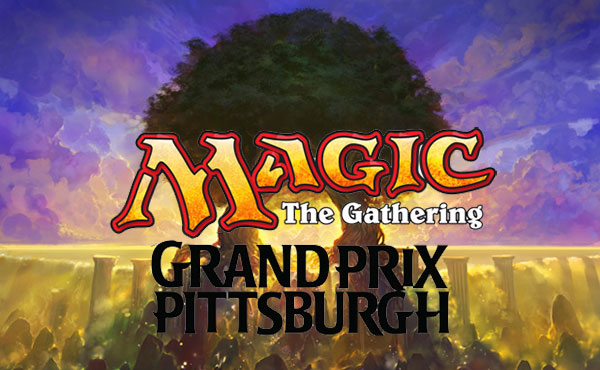
Ignoring Chicago's teeth-gnashing loss to Minnesota at the start of the month, I'm seeing connections between my Bears' recent performances and Modern's RPTQ results. In both cases, disheartening October finishes paved the way for promising November comebacks: I'll be breaking down the key RPTQ numbers today and, spoiler alert, the stats are exciting. Also in both cases, these early November victories are pointing to big showdowns at the end of the month. For the Bears, that's the Packers game on Thanksgiving night. For Modern, that's GP Pittsburgh.
Whether you're attending the Grand Prix or spamming salt shakers on Twitch, the RPTQ numbers are critical datapoints you'll need to know if you want to get ahead of the GP action. Today, we'll take a look at the big performers at the RPTQ circuit before moving into three predictions for Pittsburgh itself. Even if you know as much about the NFL and the Bears as I know about BFZ Sealed (watching GP Atlanta felt like watching Netrunner), today's article will get you deep into the Modern metagame context as you prepare for Saturday.
[wp_ad_camp_1]
RTPQ Quick Hits
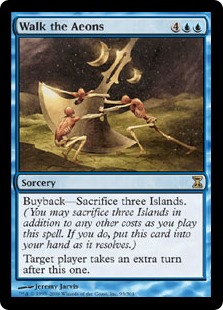 One of the biggest criticisms of metagame data is that it doesn't always represent good players and good decks. We don't "weigh" non-Grand Prix/Open finishes (we do weigh the GP/Open ones), so the Jund list earning gold at a 200 person PPTQ is treated the same as the winning Time Walk deck at a 20 player weekend tourney. This makes RPTQs unusually valuable because they represent a metagame of winning players. Earning an RPTQ invite means winning a PPTQ, T8ing an old RPTQ, or existing pro status. SCG States gave us a wealth of metagame information, not to mention plenty of zany decks, and that was a tournament circuit that didn't have this entry-bar. As such, we can use the RPTQ results to see not only what the best players are piloting, but also what decks are winning in that environment. I can't think of a better way to research for Pittsburgh than to browse the results!
One of the biggest criticisms of metagame data is that it doesn't always represent good players and good decks. We don't "weigh" non-Grand Prix/Open finishes (we do weigh the GP/Open ones), so the Jund list earning gold at a 200 person PPTQ is treated the same as the winning Time Walk deck at a 20 player weekend tourney. This makes RPTQs unusually valuable because they represent a metagame of winning players. Earning an RPTQ invite means winning a PPTQ, T8ing an old RPTQ, or existing pro status. SCG States gave us a wealth of metagame information, not to mention plenty of zany decks, and that was a tournament circuit that didn't have this entry-bar. As such, we can use the RPTQ results to see not only what the best players are piloting, but also what decks are winning in that environment. I can't think of a better way to research for Pittsburgh than to browse the results!
The table below reflects the fifteen highest-performing decks from the RPTQ scene. This translates to all decks with 2%+ of the RPTQ metagame, a cutoff selected by constructing a confidence interval around the average deck prevalence in all RPTQs. Methods like this reduce the "noise" around all the results, allowing us to focus on the performances that matter (I also added in four lower-share decks I want us to think about). In addition, the table includes a column replicating the 10/1 - 10/31 metagame data, just so you can see the RPTQ results in context.
29 events, over 230 decks, and a ton of interesting takeaways! We're going to use these metagame results to help inform our predictions later, but before we get into that, here are some quick-hit takeaways from the RPTQ scene.
 BGx is everywhere. It's the most-played deck supertype at 18.5% and saw a collective 6% point jump from the October metagame into the RPTQs. Abzan had a bigger jump relative to its October share, but Jund still pulled out a major increase for a deck that already had sizable numbers. I'll talk about this more below, but expect serious BGx opposition at Pittsburgh.
BGx is everywhere. It's the most-played deck supertype at 18.5% and saw a collective 6% point jump from the October metagame into the RPTQs. Abzan had a bigger jump relative to its October share, but Jund still pulled out a major increase for a deck that already had sizable numbers. I'll talk about this more below, but expect serious BGx opposition at Pittsburgh.
- URx Twin is definitely back. Following declines in the late summer and fall, all the Twin decks are pushing back into the big leagues. The URx Twin supertype constitutes 15.1% of the RPTQ scene, taking up a share just behind BGx. All the Twin decks enjoyed a collective 4.9% point increase, with UR Twin leading the pack at +2.4%. Be prepared for Twin at Pittsburgh!
 With the notable exception of Affinity, all the linear decks retreated during the RPTQs. Infect took a truly staggering hit (-4% relative to October), but Gruul Zoo, Burn, Merfolk, Bogles, RG Tron, and others all saw decreases around the -1% range. Astute readers will also see another deck that escaped the linear decline, but I'll save that "vigorous" contender for my predictions below... This is overall good news, because it suggests the best players are leaning towards interactive builds instead of slinging whatever turn three deck they can get their hands on.
With the notable exception of Affinity, all the linear decks retreated during the RPTQs. Infect took a truly staggering hit (-4% relative to October), but Gruul Zoo, Burn, Merfolk, Bogles, RG Tron, and others all saw decreases around the -1% range. Astute readers will also see another deck that escaped the linear decline, but I'll save that "vigorous" contender for my predictions below... This is overall good news, because it suggests the best players are leaning towards interactive builds instead of slinging whatever turn three deck they can get their hands on.
- Control decks are not what you want to be doing in Modern right now. Outside of Scapeshift, control decks across the spectrum continue to lag in Modern. This include Grixis, Jeskai, UW, Lantern, and other control notables. Enterprising brewers might be able to combat this narrative, but for the most part, read it as a sign that you should stay away. Scapeshift, as I'll discuss later, seems like a much better choice, enjoying small but notable gains in the periods.
 Company decks keep proving they are here to stay in Modern. Although Elves (not shown) lagged behind the rest at a measly .9% RPTQ share, both Abzan Company and Naya Company were going strong in the 2.5%-3% range. Pittsburgh is sure to see these decks, especially if aggro players adopt a more resilient stance by moving towards Company and away from blitz approaches.
Company decks keep proving they are here to stay in Modern. Although Elves (not shown) lagged behind the rest at a measly .9% RPTQ share, both Abzan Company and Naya Company were going strong in the 2.5%-3% range. Pittsburgh is sure to see these decks, especially if aggro players adopt a more resilient stance by moving towards Company and away from blitz approaches.
- Although Grixis Control continues to struggle with the faster metagame, Grixis Midrange decks (the kinds that eschew Cryptic Commands for Inquisition of Kozilek playsets) might be on the verge of a format-wide rise. The Midrange-Control shares have almost swapped over the past few months, and the trend looks to continue into Pittsburgh. Check out Trevor's article on Grixis' evolution for more on this shift.
As always, we need to moderate our expectations for this kind of data. RPTQ numbers aren't direct predictors of Pittsburgh any more than the October numbers predicted the RPTQs themselves. These numbers just describe a context that you'll need to consider in making your GP predictions. These limitations are important to remember as we get into the predictions themselves.
With the RPTQ numbers laid down as our foundation, here are my three predictions for Pittsburgh. I'm going big on some of these predictions instead of going safe, so hopefully the data trends hold true into the tournament (and hopefully I'm reading those trends correctly!).
1. Jund will be ready for aggro
 In Jund we trust! Proving that Lightning Bolt and Tarmogoyf are exactly where you want to be in interactive Modern, Jund plowed through the RPTQ circuit en route to its 12.1% share. Speaking of "plowing", that about describes Jund's trajectory from September through the present. The deck has smashed through the competition from its 7.9% share in September to an 8.1% share at SCG States. Next it was the 8.7% share at the end of October, and now we're looking at the RPTQ's 12.1%. I'm heartened that this movement happened alongside a general uptick in linear decks: it points to Jund's adaptability and power in hostile metagames.
In Jund we trust! Proving that Lightning Bolt and Tarmogoyf are exactly where you want to be in interactive Modern, Jund plowed through the RPTQ circuit en route to its 12.1% share. Speaking of "plowing", that about describes Jund's trajectory from September through the present. The deck has smashed through the competition from its 7.9% share in September to an 8.1% share at SCG States. Next it was the 8.7% share at the end of October, and now we're looking at the RPTQ's 12.1%. I'm heartened that this movement happened alongside a general uptick in linear decks: it points to Jund's adaptability and power in hostile metagames.
 Even if Jund was overrepresented going into the RPTQ Top 8 (more pilots bringing it in the first place), that still points to a big Jund showing at Pittsburgh. It suggests good players are bringing Jund into uncertain and potentially overly-linear metagmes, which is much healthier than slinging your own fast deck in an attempt to outgun the enemy. Bolt and Goyf are big reasons for this, but another underappreciated hero is surely Inquisition of Kozilek. When you have no idea whether to expect Gruul Zoo, Infect, Bogles, Burn, Affinity, etc., Inquisition has your back. It's no coincidence Grixis decks are turning to the powerful and painless discard spell to beat the heat too.
Even if Jund was overrepresented going into the RPTQ Top 8 (more pilots bringing it in the first place), that still points to a big Jund showing at Pittsburgh. It suggests good players are bringing Jund into uncertain and potentially overly-linear metagmes, which is much healthier than slinging your own fast deck in an attempt to outgun the enemy. Bolt and Goyf are big reasons for this, but another underappreciated hero is surely Inquisition of Kozilek. When you have no idea whether to expect Gruul Zoo, Infect, Bogles, Burn, Affinity, etc., Inquisition has your back. It's no coincidence Grixis decks are turning to the powerful and painless discard spell to beat the heat too.
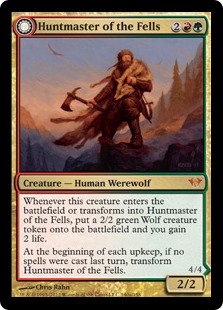 Expect to see lots of Jund at the Grand Prix (especially Day 2), and expect those Jund decks to be tailored to handle aggro. This is going to come in both the sideboard and in the maindeck. Game 1 Kitchen Finks is a definite possibility, and I'd bet the farm on Huntmaster of the Fells showing up in Jund's 60. Dark Confidant will probably stick around, just because he's such an easy swap in games 2-3 if needed, but the removal suite is going to tend cheap (Bolt, Decay, Terminate). Sweepers will abound in the board. If you're feeling next-level, you can get ahead of this trend by playing cards and decks that blank Jund's interactions, or by going over the top (see the next prediction...). For example, a well-constructed Abzan deck could definitely enjoy strong position going into the event, even if you wouldn't expect a lot of people to play Abzan in the first place.
Expect to see lots of Jund at the Grand Prix (especially Day 2), and expect those Jund decks to be tailored to handle aggro. This is going to come in both the sideboard and in the maindeck. Game 1 Kitchen Finks is a definite possibility, and I'd bet the farm on Huntmaster of the Fells showing up in Jund's 60. Dark Confidant will probably stick around, just because he's such an easy swap in games 2-3 if needed, but the removal suite is going to tend cheap (Bolt, Decay, Terminate). Sweepers will abound in the board. If you're feeling next-level, you can get ahead of this trend by playing cards and decks that blank Jund's interactions, or by going over the top (see the next prediction...). For example, a well-constructed Abzan deck could definitely enjoy strong position going into the event, even if you wouldn't expect a lot of people to play Abzan in the first place.
Overall, I'm banking on Jund fulfilling its role as format policeman, and betting that players see it this way too. Jund might not win the event (might not even Top 8 it!), but it will be there to hold the line and keep the peace.
2. Amulet Bloom will beat the hate
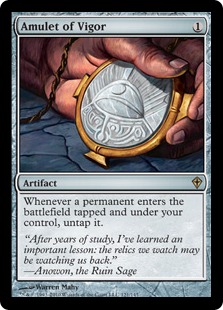 I'm confident Jund is going to do a great job at checking all those Cranial Platings, Wild Nacatls, and Become Immenses. Then again, I'm also confident a few decks might slip through Jund's hate arsenal. The best candidate for this is Amulet Bloom. We're already seeing Bloom's success in a big way throughout the RPTQ numbers. The deck saw a huge jump from its October share of 4.1% to an RPTQ-high of 7.3%, which continues a two-month trajectory that took us from September (3.7%) into SCG States (4.4%). This persistent trend suggests Amulet Bloom is legitimately well-positioned to cause damage at Pittsburgh, and the aggro-occupied Jund mages won't be in a good place to stop it.
I'm confident Jund is going to do a great job at checking all those Cranial Platings, Wild Nacatls, and Become Immenses. Then again, I'm also confident a few decks might slip through Jund's hate arsenal. The best candidate for this is Amulet Bloom. We're already seeing Bloom's success in a big way throughout the RPTQ numbers. The deck saw a huge jump from its October share of 4.1% to an RPTQ-high of 7.3%, which continues a two-month trajectory that took us from September (3.7%) into SCG States (4.4%). This persistent trend suggests Amulet Bloom is legitimately well-positioned to cause damage at Pittsburgh, and the aggro-occupied Jund mages won't be in a good place to stop it.
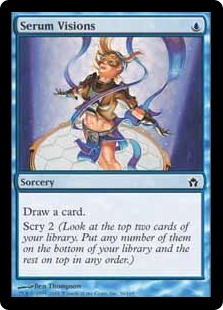 The Modern community has been bombarded with pros and players alike raving about how good this deck is, all based on test data (at best) or anecdotal evidence (at worst). We haven't seen a shred of real metagame data to suggest Bloom's dominance since spring, so these opinions often come off as alarmism and hype. The recent numbers, particularly those at the RPTQ, indicate the hype might finally be taking root in reality. We can certainly identify deck developments that might play into this. Bloom decks have embraced a cantrip-heavy (Serum Visions and the Storm throwback Sleight of Hand) version, valuing redundancy and games 2-3 power over a turn two win. Temple of Mystery is even seeing play, a card with obvious bounceland synergy. If the deck could succeed at the RPTQ scene, despite the player caliber and being a known entity, its Pittsburgh prospects are excellent.
The Modern community has been bombarded with pros and players alike raving about how good this deck is, all based on test data (at best) or anecdotal evidence (at worst). We haven't seen a shred of real metagame data to suggest Bloom's dominance since spring, so these opinions often come off as alarmism and hype. The recent numbers, particularly those at the RPTQ, indicate the hype might finally be taking root in reality. We can certainly identify deck developments that might play into this. Bloom decks have embraced a cantrip-heavy (Serum Visions and the Storm throwback Sleight of Hand) version, valuing redundancy and games 2-3 power over a turn two win. Temple of Mystery is even seeing play, a card with obvious bounceland synergy. If the deck could succeed at the RPTQ scene, despite the player caliber and being a known entity, its Pittsburgh prospects are excellent.
 As usual, Modern's best single-card defense against Amulet Bloom is Blood Moon. Also as usual, Modern's best policeman deck against Amulet Bloom is UR Twin, which is incidentally the best Moon deck in Modern's top-tier. This puts us in an interesting metagame position where Twin is angled to stop Bloom, but where Bloom has also shown considerable game against Twin: it's worrisome that Bloom can put up a 7% metagame share in an RPTQ series that was also 15% Twin (most of which was UR Twin specifically). This could hint at Bloom's developing a better gameplan in its worst matchup. If so, that would mean Amulet is well-positioned to punch into the top tables even through hate.
As usual, Modern's best single-card defense against Amulet Bloom is Blood Moon. Also as usual, Modern's best policeman deck against Amulet Bloom is UR Twin, which is incidentally the best Moon deck in Modern's top-tier. This puts us in an interesting metagame position where Twin is angled to stop Bloom, but where Bloom has also shown considerable game against Twin: it's worrisome that Bloom can put up a 7% metagame share in an RPTQ series that was also 15% Twin (most of which was UR Twin specifically). This could hint at Bloom's developing a better gameplan in its worst matchup. If so, that would mean Amulet is well-positioned to punch into the top tables even through hate.
I don't think Jund has what it takes to stop Bloom, both because the BGx deck is too focused on other matchups and because Bloom just rolls over Jund in games 2-3 once it enters big-mana-ramp mode. This means Twin will decide Bloom's fate at Pittsburgh, and I think Bloom players have improved this matchup past its old 30-70 or 40-60 range (at least, if the prevalence stats are any indication). It's also unclear if Twin can weather the Jund uptick, so they might not be around in the first place. Expect to see a respectable Bloom showing in Day 2 and, if Twin doesn't do its part, at least one copy in the Top 8/16.
3. Scapeshift will Top 8
 Time to go bold or go home. If I had to roll the dice for one deck at Pittsburgh, it would be for Scapeshift. Jeff Hoogland has been working hard to get the Bring to Light version of this deck online, and the Modern community has responded with a handful of finishes with both the 4-5 color toolbox lists and traditional Temur versions. Both styles have seen noteworthy metagame increases since September, culminating in a solid RPTQ showing at around 3%. Although this is hardly at the same level of Jund or even Abzan, it's the kind of pre-trend I'm jumping on as I make my riskiest prediction. The numbers point towards newfound viability: now we just need the players to jump aboard too.
Time to go bold or go home. If I had to roll the dice for one deck at Pittsburgh, it would be for Scapeshift. Jeff Hoogland has been working hard to get the Bring to Light version of this deck online, and the Modern community has responded with a handful of finishes with both the 4-5 color toolbox lists and traditional Temur versions. Both styles have seen noteworthy metagame increases since September, culminating in a solid RPTQ showing at around 3%. Although this is hardly at the same level of Jund or even Abzan, it's the kind of pre-trend I'm jumping on as I make my riskiest prediction. The numbers point towards newfound viability: now we just need the players to jump aboard too.
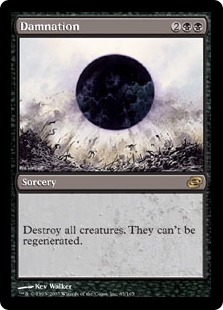 Scapeshift is that rare combo deck which can play a very solid anti-aggro game, perform a serviceable control imitation, and rock the proactive, out-of-nowhere combo win. It has the huge added bonus of blanking a swath of removal spells clogging the field, and an ability to maindeck serious sweepers in Anger of the Gods and even the almighty Damnation in Bring to Light versions. Trevor Holmes already "brought" us a brew with the toolbox sorcery alongside Gifts Ungiven, and I'm expecting other players to jump on the Scapeshift and Bringing train in preparation for Pittsburgh. Take a look at Jack Wang's RPTQ-winning list to see this strategy executed.
Scapeshift is that rare combo deck which can play a very solid anti-aggro game, perform a serviceable control imitation, and rock the proactive, out-of-nowhere combo win. It has the huge added bonus of blanking a swath of removal spells clogging the field, and an ability to maindeck serious sweepers in Anger of the Gods and even the almighty Damnation in Bring to Light versions. Trevor Holmes already "brought" us a brew with the toolbox sorcery alongside Gifts Ungiven, and I'm expecting other players to jump on the Scapeshift and Bringing train in preparation for Pittsburgh. Take a look at Jack Wang's RPTQ-winning list to see this strategy executed.
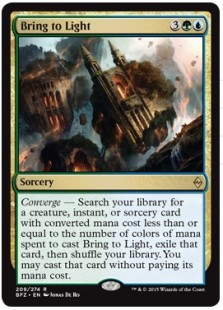 I'm going out on the limb for Scapeshift because I think it has the right mix of proactivity and reactivity to exploit holes in the current metagame. It's proactive enough to close out a game fast with the coveted turn 4-5 Scapeshift, which is something a stalled linear deck can't answer. It also plays the removal and sweepers to survive into those critical turns on more than a cointoss. Moreover, the Bring to Light version has ample tools to go over the top of midrange, particularly whenmidrange is geared to fight aggro. Here's hoping for Scapeshift to make the cut into the later rounds, but don't be too disappointed if the dream never materializes.
I'm going out on the limb for Scapeshift because I think it has the right mix of proactivity and reactivity to exploit holes in the current metagame. It's proactive enough to close out a game fast with the coveted turn 4-5 Scapeshift, which is something a stalled linear deck can't answer. It also plays the removal and sweepers to survive into those critical turns on more than a cointoss. Moreover, the Bring to Light version has ample tools to go over the top of midrange, particularly whenmidrange is geared to fight aggro. Here's hoping for Scapeshift to make the cut into the later rounds, but don't be too disappointed if the dream never materializes.
Prepare for GP Pittsburgh!
Metagame data is only one part of your preparations for Pittsburgh, and it won't mean much if you haven't been getting your deck reps in before now. If you have your deck ready to go, or are thinking of a last-minute switch, then the RPTQ data and the broader metagame context will be invaluable as you ready for the weekend. As far as I'm concerned, the toughest choice I'll be making on Sunday is whether to watch Bears vs. Broncos or catch the tail-end of Pittsburgh's Day 2.
What are your predictions for Pittsburgh? Any RPTQ or metagame trends I missed or misjudged? Got any exciting deck or travel plans for the weekend? Bring it down to the comments and stay optimistic as we go into the weekend. If the Bears defense could hold the Rams offense to just 13 points last Sunday (zero Jay Cutler interceptions too!), then we can all hold out hope for a healthy, exciting, and awesome Modern event coming up this weekend.





Nice article!
One minor comment: you lump Burn in with other aggro decks as losing ground, but it’s stayed exactly level at 7.8% according to your chart. This doesn’t surprise me too much, as looking over the meta game and the deck lists I can get ahold of from major events, there’s not a ton of hate for Burn match ups right now. Jund and Junk decks, for example, appear to be largely stepping back from Feed the Clan (a massive burn hoser), instead opting for softer answers such as Kitchen Finks and Timely Reinforcements in the board, which are MUCH easier to manage with Skullcrack/Atarka’s Command. This is perfectly reasonable; why target Burn, which is 7-8% of the meta, when Affinity is a massive 12% of the meta, but it certainly helps Burn’s match up vs those decks. In general, the meta seems decent for Burn, with only Bloom Titan being a noticeably bad match up and plenty of even or slightly favorable match ups (depending on deck builds and SB choices) in Twin, UBx, and Tron.
I should have phrased that differently with some specific numbers, because it has lots ground from its summer shares of 8%+. I didn’t include that though, which is my bad. Also, I actually think a flat 0% change for Burn within this period is a form of losing ground. It’s not as if all the other linear players just transitioned over to the easy Burn pick, which is something we see in more open metagames. Definitely should have been more clear about that, but it’s very interesting that Burn has hovered around that share for the last few months and hasn’t gone up since.
Personally, I would look to see UWR control place top 16 in this event–My reasoning:
1. UWR is one of the few decks to have real flexibility in an open metagame–the primary school of thought in modern is that robust power is one of the best bets in an unknown metagame, but there is a class of player that prefers flexibility over raw power.
2. Spot removal is at an all-time high in importance in modern–UWR and UBR are the two wedges with the most robust removal suites, but UWR has better tools for abusing sweepers, which are also probably strong at this event. More to the point, UWR is more likely to have hard sweepers in the mainboard, and it certainly has the most flexible/powerful sideboard options.
3. Bloom/Twin/BGx are all running fairly high at the moment–I see this as conditions for more blood moon effects in the metagame, both because players see twin performing well and shift to it, and because the perception is that bloom is on the rise AND fairly weak to blood moon. Regardless, higher prevalence of blood moon as disruption means that URx shells start to have some natural advantages in the format because they aren’t *as* weak to blood moon to begin with, and blood moon pushes out other sideboard options that can be more hateful to UWR.
4. Nobody is gunning for control. This isn’t 2012 anymore, UWR isn’t a top tier deck; with the race to the bottom in terms of speed and noninteractivity over the last few months, people’s sideboards have scaled back to interact with those decks and control hosers are at an all time low in modern sideboards.
Tag didn’t appear–now it has my handle attached to it.
I’m going to disagree with you completely.
1 – UWR has always had this flexibility, but it’s flexibility never gave it the same 50%+ against the field that you see for Jund.
In fact this whole comment describes Jund better than it describes UWR. Jund is the flexible deck in the format.
2 – Grixis arguably has better removal (Terminate over Path), a better man land in Creeping Tar Pit and access to Kolaghan’s Command. UWR gets Lightning Helix and better sideboard options.
Perhaps a better argument is that UWR is better positioned against Zoo/Company decks, not sure if that’s true buy I wouldn’t argue against it.
3 – I play UR Twin, I always bring in my Moons against UWR. Blood Moon wins games against UWR. If you’re expecting Blood Moon, I wouldn’t play UWR.
4 – nobody is gunning for control, but they are gunning for Twin and Scapeshift and you’ll suffer the splash damage. Also this argument has been argued to death for the last 3 years, and each time UWR fails to deliver.
Unfortunately the deck is just missing something and I’m not sure what it is. But the problems I see are:
1 – it’s greedy mana base
2 – it’s slow win pace (the deck just doesn’t change gears fast enough)
3 – there’s no Tasigur/Goyf equivalent in UWR – the closest is probably Restoration Angel, which can be dropped end of turn.
4 – a reactive game plan, which is currently the death knell for decks in Modern. This is because in an open field you’re going to need a proactive plan in certain matches. I call it the “free win theory”, if your deck doesn’t have free wins then it’s probably not going to do well.
I don’t disagree with the assessment that jund is more flexible; but there is a certain class of player that prefers reactive flexibility to proactive flexibility, and those include some of the best players in the history of the game. There’s a reason McLaren consistently does super well at large modern events playing UWR variants. I also want to point out that the UWR deck does have a long pedigree of being a reasonable choice in the modern metagame; it hasn’t been out of tier two status for THAT long, and it certainly spent more time in tier two than many of the decks currently there. I will also point out that the last time they did a deep-dive in modern, UWR control was actually one of the best decks when piloted by a skilled player–I seem to remember the number was something like a 67% mwp overall for the better pilots, which is insane–that’s comparable to the best HOF players at their career peaks. Do I think it’s going to be a big part of the metagame? hell no. Do I expect to see a couple of good pilots break day two and a VERY skilled pilot break top 16? I wouldn’t be surprised.
I’m not arguing for it to win or make a big impact, but it is probably my top choice deck to put a skilled pilot into a good finish.
Playing a deck with Path to Exile and Mana Leak remains a losing proposition.
Currently watching GP Pittsburgh… Not sure what all that Jund data was about, but this is awful. Even the “Jund guys”, Reid Duke and Brad Nelson, have abandoned ship. Looks like F**ckin Combo Winter up in here. What a horrible place for modern to be in.
Hate to break it to you but the Day 2 statistics http://magic.wizards.com/en/events/coverage/gppit15/day-2-metagame-breakdown-2015-11-22
and the Top Eight do not back up the claim. Three Twins, two Affinity, and one each of Scapeshift (nicely called Sheridan), Grixis, and GW Hatebears is not a Combo Winter scenario. The combo decks that did the best here are all the “fair” combos. And GBx did take 1/3 of the undefeated slots Day One. Looking at Day 2 Amulet Bloom had a good showing but dropped off precipitously and Grishoalbrand was a very small percentage. If I were to guess, the coverage team went for the most unusual decks to showcase rather than the Jund matchups that we’ve seen hundreds of times. I expect that we’ll be seeing a lot of pro’s complaining about their deck choices and how they Next Leveled themselves rather than play the deck they knew.